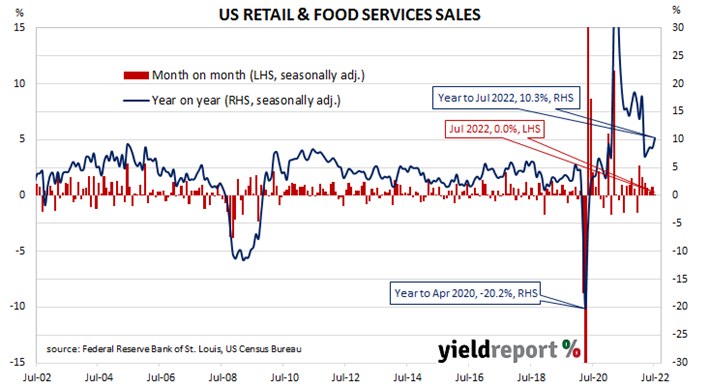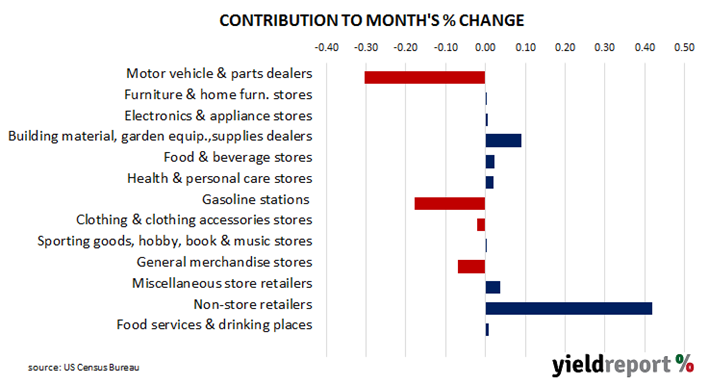Summary: US retail sales flat in July, less than expected; June figure revised down; report’s details imply ex-auto sales stronger than expected; US Treasury bond yields up, rate rise expectations firm; lower fuel sales offset by spending elsewhere; rises in nine of thirteen retail categories; “non-store” segment largest single influence.
US retail sales had been trending up since late 2015 but, commencing in late 2018, a series of weak or negative monthly results led to a drop-off in the annual growth rate below 2.0%. Growth rates then increased in trend terms through 2019 and into early 2020 until pandemic restrictions sent it into negative territory. A “v-shaped” recovery then took place which was followed by some short-term spikes as federal stimulus payments hit US households in the first and second quarters of 2021.
According to the latest “advance” numbers released by the US Census Bureau, total retail sales remained steady in July. The flat result was slightly less than the 0.1% gain which had been generally expected but considerably lower than June’s 0.8% after it was revised down from 1.0%. However, on an annual basis, the growth rate still accelerated from June’s revised figure of 8.5% to 10.3%.
“US retail sales didn’t grow in July, which was below consensus expectations for a 0.1% lift,” said ANZ economist Madeline Dunk. “But the details of the release were stronger than expected, with retail sales ex-auto and gas lifting 0.7%, versus 0.4% expected.”
US Treasury bond yields rose on the day, especially at the long end. By the close of business, the 2-year Treasury yield had inched up 1bp to 3.27%, the 10-year yield had gained 9bps to 2.90% while the 30-year yield finished 6bps higher at 3.15%.
In terms of US Fed policy, expectations of a steeper path for the federal funds rate over the next 12 months firmed a little. At the close of business, September contracts implied an effective federal funds rate of 2.525%, 20bps higher than the current spot rate. November contracts implied 3.30% while September 2023 futures contracts implied an effective federal funds rate of 3.535%, about 120bps above the spot rate.
“Falling gas prices in the month contributed to a 1.8% fall in gas station sales, with the result suggesting consumers much of this benefit was directed into other spending,” said NAB economist Taylor Nugent.
Nine of the thirteen categories recorded higher sales over the month. The “Non-store retailer” segment provided the largest single influence on the overall result, rising by 2.7% for the month and by 20.2% over the year to July. Sales in the “Motor vehicles & parts dealers” segment also had a significant influence on the month’s result, falling by 1.6%.
The non-store segment includes vending machine sales, door-to-door sales and mail-order sales but nowadays this segment has become dominated by online sales. It now accounts for just over 16% of all US retail sales and it is the second-largest segment after vehicles and parts.



